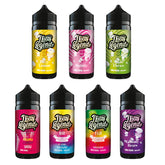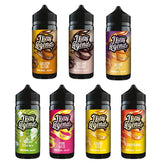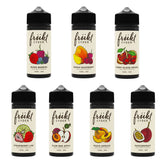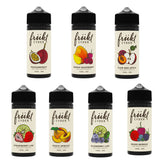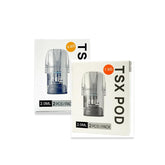Vaping isn’t just a habit—it’s a lifestyle for many. Whether you're into clouds or just weaning off traditional cigarettes, choosing the right e-liquid brand matters. Among the most talked-about names is Nasty Juice, famous for its fruity blends and edgy branding. But as vaping continues to rise in popularity, so do concerns about what goes into your vape juice. One of the most important questions asked by our customers at Vape4World is:
Does Nasty Juice contain diacetyl?
This isn’t just a technical curiosity—it’s a serious health question. In this guide, we break it down for you with expert-backed insights, real risks, and safer vape practices.
Also Read: How to Open a Nasty Juice Bottle
What Is Diacetyl and Why Should Vapers Be Concerned?
Diacetyl is a chemical compound used widely in food flavoring, especially to mimic buttery and creamy profiles. Safe for eating? Yes. Safe for inhaling? Absolutely not.
Back in the early 2000s, workers at popcorn factories developed a serious lung disease called bronchiolitis obliterans—nicknamed popcorn lung—after breathing in diacetyl vapors. This irreversible condition results in scarring and narrowing of the airways.
In vaping, diacetyl isn’t always visible on the label. It can sneak into e-liquids, especially dessert and creamy flavors, and that’s where the problem lies. Many vapers unknowingly inhale it daily.
How Diacetyl Makes Its Way into E-Liquids
Creating rich, indulgent flavors is a big part of what makes vaping enjoyable. Unfortunately, achieving creamy or buttery notes often requires using a group of chemicals called diketones. These include:
-
Diacetyl
-
Acetoin
-
Acetyl Propionyl
While these compounds are approved for ingestion, inhalation is a different story. Some e-liquid brands—especially older or cheaper ones—still rely on these diketones to mimic dessert flavors.
Without clear labeling or third-party testing, vapers can’t always be sure what they’re inhaling. This makes brand transparency critical.
Why Is Nasty Juice So Popular Among Vapers?
If you’ve vaped for any time at all, chances are you've heard of Nasty Juice. It's more than just a clever name. The brand has skyrocketed in global popularity for several reasons:
-
Bold, tropical fruit flavors like Cush Man (mango) and Bad Blood (blackcurrant)
-
High VG ratios, great for cloud production
-
Salt nic options for those who prefer smoother hits
-
Distinctive, collectible packaging
Despite all the accolades, one thing remains unclear: the safety of their ingredients. For a brand this popular, you'd expect more transparency. Yet information about diacetyl or diketone content remains hard to find.
Does Nasty Juice Contain Diacetyl? The Uncomfortable Truth
Currently, Nasty Juice has not released any third-party lab results verifying that their products are free from diacetyl, acetoin, or acetyl propionyl. This doesn’t automatically mean those compounds are present—but the lack of confirmation is troubling.
Brands that value consumer safety usually go out of their way to disclose such information. Transparency equals trust. Without it, we're left guessing, and that's not acceptable when your lungs are involved.
Scientific Evidence: What Research Tells Us About Diacetyl Exposure
A Harvard University study from 2015 tested 51 flavored e-liquids. The shocking result? 39 contained diacetyl—even those labeled as diacetyl-free.
Popcorn lung is rare, yes. But it's real. Continued exposure to diacetyl and similar compounds poses genuine health risks over time. Most cases may not be traced back directly to vaping, but it’s not worth the gamble.
The takeaway? Even small exposures add up, especially for daily users.
Understanding Labels: How to Read Vape Juice Packaging Like a Pro
Being an informed vaper starts with label reading. Here’s how to identify safer options:
-
Look for Diacetyl-Free or Diketone-Free claims
-
Check for links or QR codes to lab test results
-
Watch out for vague terms like natural flavors or aroma compounds
-
Ask your vape supplier for lab results
At Vape4World, we only stock products from brands that value transparency and safety.
Should You Trust Brands Without Lab Test Results?
Ask yourself this: Would you eat food with no ingredient label? Then why vape products without lab reports?
Brands like Nasty Juice that avoid publishing third-party testing leave users in a dangerous gray area. No amount of marketing or pretty packaging makes up for the unknown.
It's not about fear—it's about responsibility. You deserve to know what you’re inhaling.
Safe Vape Juice Alternatives to Nasty Juice
Looking for peace of mind without sacrificing flavor? Consider switching to reputable, lab-tested brands:
-
Black Note – Tobacco-focused, all-natural, transparent
-
VaporFi – Popular for fruity blends and full batch testing
-
Halo Cigs – Clean ingredients and rigorous testing
-
Naked 100 – Great fruit blends, but check diketone status by line
These brands go beyond marketing—they provide data. That’s what safety looks like.
Are Regulations Enough to Keep Diacetyl Out of Your Vape?
Let’s talk law. Here’s how different regions regulate diacetyl in vape juices:
-
UK & EU (TPD): Requires ingredient listings but doesn’t outright ban all diketones
-
USA (FDA): Ongoing PMTA process, but many products still lack full review
-
Asia (including Malaysia): Regulations vary widely; some countries have no strict oversight
While regulation helps, it doesn’t replace brand accountability. Never assume legal means safe.
Will One Bottle of E-Liquid Harm You?
Let’s be fair. Vaping one bottle of juice with trace diketones won’t destroy your lungs.
But what about months of daily use? Or years? Cumulative exposure is where the real danger lies. Even minimal levels of diacetyl, inhaled regularly, can result in long-term respiratory damage.
Informed decisions now can protect you later.
Also Read: Nasty Juice E-Liquids: Flavors, Reviews, and More
What We Tell Vape4World Customers About Nasty Juice
Customers frequently ask us, Is Nasty Juice safe?
Our response? If you love fruity blends, go ahead—just skip the dessert lines unless they publish lab results. Until then, better safe than sorry.
It’s not about throwing shade—it’s about protecting your health.
Smart Shopping Tips for Vapers Who Prioritize Health
Want to vape responsibly? Follow these tips:
-
Only buy from reputable suppliers (like Vape4World)
-
Research the brand and ask for lab results
-
Avoid creamy/dessert flavors unless verified diketone-free
-
Stay updated on industry reports and findings
When you know better, you vape better.
The Vape Industry’s Role in Consumer Safety
Brands have a responsibility beyond flavor. Transparency, third-party testing, and honest marketing should be the baseline, not the exception.
At Vape4World, we believe in pushing the industry toward higher safety standards. If we don’t demand better, nothing changes.
Final Thoughts: Don’t Let Uncertainty Cloud Your Health
Does Nasty Juice contain diacetyl? Maybe. Maybe not. But the lack of public testing data is enough reason to pause.
Your lungs are too valuable to risk. Choose brands that prove their safety. Demand third-party testing. Stay informed.
Because in the world of vaping, the smartest choice is always the safest one.
FAQs:
1. What is the difference between diacetyl and acetyl propionyl?
Both are diketones, chemicals used to create buttery or creamy flavors in e-liquids. While diacetyl is more widely known for its association with popcorn lung, acetyl propionyl is considered less harmful but still carries potential risks when inhaled over time.
2. Are there any Nasty Juice flavors that are specifically labeled as diacetyl-free?
Currently, Nasty Juice does not provide clear labeling or third-party lab results for their products regarding diacetyl or other diketones. Without such confirmation, it's best to assume that their e-liquids might contain traces of harmful compounds.
3. How can I ensure that the e-liquids I buy are safe from diketones?
Always look for brands that offer verified third-party lab results. Reputable companies will be transparent about their ingredients and testing processes, showing you exactly what’s in the e-liquid before you purchase.
4. Is there a legal ban on diacetyl in vape juice?
Currently, there is no worldwide ban on diacetyl in vape juices. Some regions have stricter regulations than others, but consumers should take extra precautions and opt for brands that test their products and share the results.
5. Can using Nasty Juice occasionally cause lung damage?
While occasional use is less likely to cause immediate harm, frequent or long-term use of e-liquids containing diacetyl can lead to significant health risks, including chronic respiratory issues. It's best to opt for tested and verified products to minimize exposure.
6. What are the safest alternatives to Nasty Juice for vapers who care about health?
For vapers seeking safer options, brands like Black Note, VaporFi, and Halo Cigs offer e-liquids tested for the absence of harmful chemicals, providing a safer vaping experience without compromising on flavor.
7. Can vaping Nasty Juice cause popcorn lung in the long term?
Popcorn lung (bronchiolitis obliterans) is a rare but real condition caused by inhaling diacetyl over time. Though not directly proven from vaping, long-term exposure to diacetyl-containing e-liquids could potentially contribute to respiratory issues.
8. Why do some e-liquids still contain diacetyl?
Despite the health risks associated with diacetyl, some e-liquid manufacturers continue to use it to achieve rich, buttery, and creamy flavors. Often, it's used in budget-friendly products due to its lower cost compared to safer alternatives.




